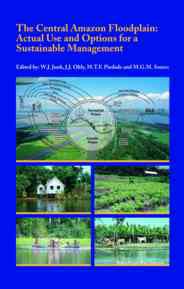

Sustainable management of wetlands is a subject of increasing public interest, because loss of wetlands and related biodiversity is reaching alarming dimensions worldwide. Large pristine wtlands still exist in tropical South America. However during the last decades there has been an increasing pressure to utilize them. They are considered valuable because they provide land resources for agriculture and animal ranching and offer also fish, forest products, water, transport facilities, possibilities for tourism and other benefits. Lack of knowledge and conflicts of interest often lead to inadequate use of the resources and sometimes to serious damage of the wetland systems.
The Amazon River floodplain, locally called várzea, is of specific interest for regional development because of its large size, fertile soils, abundant fishery resources, and valuable timber. Traditional small-scale subsistence farmers are facing increasing pressure from large-scale cattle and buffalo ranchers. There are plans to install large-scale paddy rice and soy bean plantations in the floodplain with dramatic consequences for the local population and the ecosystem integrity.
The book presents in 24 chapters a coherent analysis of the ecological situation, the history of land occupation, the different forms of resource utilization, the socio-economic situation of the population, and the ecological threats of human activities on the Amazon floodplain. Cost-benefit analyses of different forms of land use are compared with market demands and environmental impacts. Conflicts of interest between different stake holders (e.g., smallholders and ranchers, professional and subsistence fishermen) are described. A chapter about environmental legislation and its deficiencies points to the need for additional regulations to avoid further conflicts of interest and negative impact of human activities on the ecosystem.
It is shown that despite a relatively high ferility, the potential of the várzea for agriculture and animal farming is limited by ecological constraints related to the flood pulse. Three concepts are presented that, together, will allow the sustainable management of the natural resources. The Flood Pulse Concept describes the structure and function of the system. It is the scientific basis for the Concept of Multiple Use that recommends the optimization of the use of all resources instead of the maximization of the use of a single resource. The participation of the local population in resource management is fostered by the Concept of Decentralized and Participative Management that will also stimulate the acceptance of regulations for the protection of habitat and species diversity.
This is the first book that deals with sustainable management of a tropical
wetland with coherent and new data sets in an interdisciplinary approach, along
with a strong conceptional background. Therefore, it is not only of interest
of the sustainable management of the Amazon Rover floodplain, but it serves
as a conceptional basis for the sustainable management in general.
Edited by W.J. Junk, J.J. Ohly, M.T.F. Piedade &
M.G.M. Soares
2001, xxvi and 590 pages with 59 photographs, 57 linedrawings and 114 tables.
Hardbound.
ISBN 90-5782-074-9
€ 142